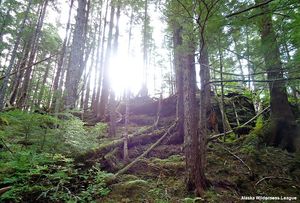Difference between revisions of "Tongass National Forest"
| Line 1: | Line 1: | ||
| − | [[File:Sitka waterfall 6173285451 small.jpg|thumb|left]] | + | [[File:Sitka waterfall 6173285451 small.jpg|thumb|left]] __NOTOC__ |
At 17 million acres – roughly the size of West Virginia – the Tongass National Forest is America’s largest national forest, encompassing the majority of the southeast Alaska panhandle. | At 17 million acres – roughly the size of West Virginia – the Tongass National Forest is America’s largest national forest, encompassing the majority of the southeast Alaska panhandle. | ||
Revision as of 14:59, 13 September 2018
At 17 million acres – roughly the size of West Virginia – the Tongass National Forest is America’s largest national forest, encompassing the majority of the southeast Alaska panhandle.
Rising from the deep, rich waters of Alaska’s Inside Passage, the Tongass is where people come to see Alaska. Each year more than 1 million people come to experience glaciers flowing from the mountains into the sea and iconic wildlife that thrives in one of the largest remaining temperate rainforests in the world.
Decades of clear-cutting has cost the Tongass portions of its best habitat, and yet the forest still contains some of the most intact expanses of temperate rainforest remaining in the world. The region’s economy has largely transitioned away from timber and towards diverse and sustainable industries where wildlife and wild salmon in a scenic and healthy forest employ thousands of Alaskans in recreation, tourism and commercial fishing.
Fact Sheets | Congressional Letters | Public Letters | Maps | Reports
| KEY FACTS |
|
115th Legislative Threats
- H.R. 2, 2018 Farm Bill
- H.Amdt598 from Rep. Young would exempt all National Forests in Alaska from the Roadless Rule.
- S. 1481, Alaska Native Claims Settlement Improvement Act
- From Senator Murkowski, this bill contains numerous provisions that would circumvent the 1971 Alaska Native Claims Settlement Act (ANCSA) by removing important checks and balances, especially with regard to some of Alaska’s most high quality public lands within the Tongass National Forest and the National Wildlife Refuge System.
- H.R. 232, State National Forest Management Act
- From Rep. Young, this bill would authorize states to each acquire up to two million acres of national forest lands that are currently providing economic, social and ecological benefits to our communities. It would remove land from the public trust and see it managed for short-term timber or other extractive development rather than the current federal multiple use mandate.
- H.R. 229/S. 1491, Unrecognized Community Landless Natives Authorization Act
- From Rep. Young/Sen. Murkowski, this bill would reopen ANCSA and create five new Native Corporations that would have authority to select more than 115,000 acres of high-value public lands - including in the Tongass National Forest.
- H.R. 513/S. 131, Alaska Mental Health Trust Land Exchange Act
- From Rep. Young/Sen. Murkowski, this bill would override an on-going public process to exchange public lands from the Tongass National Forest for lands currently owned by the Alaska Mental Health Trust. This bill is part of a larger legislative effort to increase logging in the Tongass National Forest.
- H.R. 1867/S. 785, Alaska Native Veterans Land Allotment Equity Act
- From Rep. Young/Sen. Sullivan, this bill would allow the transfer of nearly half a million acres of public land into private ownership, carving up Alaska’s most valuable public lands and creating thousands of inholdings in national wildlife refuges, wilderness areas and national forests.
- H.R. 2936, Resilient Federal Forests Act
- From Rep. Westerman (R-AR-4), this bill would severely undermine the National Environmental Policy Act (NEPA) and public processes environmental review and incentivizes logging, threatening the Tongass and other national forests.
- S. 1483 & S. 1484, the Shee Atika Land Exchange Settlement Act & Admiralty Island Land Exchange Finalization Act
- From Sen. Murkowski, these bills together would trade stumps for trees, where the U.S. Forest Service would receive recently logged lands, and private corporations would receive valuable, intact old-growth forests that are currently part of the Tongass National Forest.
Opportunities to Show Support
- Cosponsor S. 3333 - email Bryan Petit (mailto:Bryan_Petit@energy.senate.gov) to co-sponsor.
Talking Points
- Where America comes to see Alaska – Iconic Alaskan experience. Millions of visitors come each year to experience one of the largest remaining temperate rainforests in the world. The lands, water and wildlife of the Tongass are a prominent part of America’s outdoor heritage, and we all have a moral obligation to protect for our children and grandchildren.
- Wild works for Southeast. A wild and healthy Tongass is already supporting the robust and sustainable recreation, tourism and fishing industries. Together these industries generate approximately $2 billion annually into the region’s economy.
- Southeast Alaska has already transitioned. Timber is over and subsidized timber sales today have the effect of exporting southeast Alaska jobs and resources. Do not let our government give the Tongass away to corporate interests when they think no one is looking.
- Overwhelming support for sustainability: Thousands of Alaskans, including the Tongass Advisory Committee (which included local representatives from government, timber, Alaska Natives and conservationists), were in favor of moving forward, transitioning away from old-growth and into young growth, and supporting the region’s sustainable industries that rely on a healthy forest.
